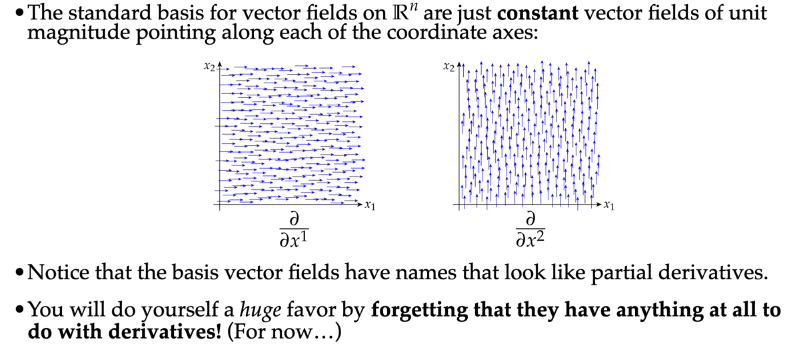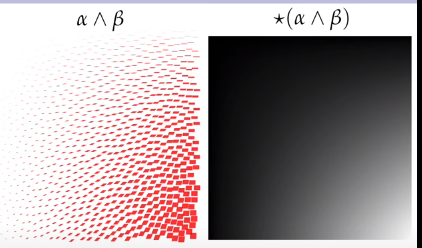DDG Lecture 5
Differential Forms in Rn
Differential k-forms
A vector field is an assignment of vectors to each point in space.
A differential k-form is an assignment of a k-form to each point.
A common abbreviation is to shorten "differential k-form" to just "k-form".
A differential 0-form is a just a scalar field.
A differential 1-form is like a vector field.
(But they are 1-forms at each point, so it is how to take a measurement at each point)
A differential 2-form is an area measurement at each point (x1,x2,x3).
Pointwise operations on Differential k-forms
(⋆α)p:=⋆(αp)(α∧β)p:=(αp)∧(βp)
Apply operator over each k-form pointwise.
Notation: omit _p.
Differential k-forms in Coordinates
Basis Vector Fields

The coeffecients of the linear combination of basis fields can vary pointwise.
For differential 1-forms, call the basis 1-forms (dual bases) dx1, dx2.
So α=α1dx1+α2dx2.
dxi(∂xj∂)=δji:={1,0,if i=jotherwise
Ex. Hodge star of differential 1-form.
Consider the differential 1-form:
α:=(1−x)dx+xdy
Q: what is the hodge star of α?
⋆α=⋆((1−x)dx)+⋆(xdy)=(1−x)(⋆dx)+x(⋆dy)=(1−x)dy−xdx
Ex. wedge of two 1-forms.
α:=xdx,β:=(1−x)dx+(1−y)dy
α∧β=xdx∧((1−x)dx+(1−y)dy)=xdx∧(1−x)dx+xdx∧(1−y)dy=x(1−x)(dx∧dx)+x(1−y)(dx∧dy)=(x−xy)(dx∧dy)
Note that in R2 all wedges of 1-forms are scalar multiples of dx∧dy.
The same information is contained in the hodge star.

⋆(α∧β)=(x−xy)
Ex. Applying a Differential 1-form to a vector field
α:=xdxX:=(1−x)∂x∂+(1−y)∂y∂
apply α to X.
α(X)=(xdx)((1−x)∂x∂+(1−y)∂y∂)=(x(1−x))(dx∂x∂)+(x(1−y))(dx∂y∂)=x−x2 
